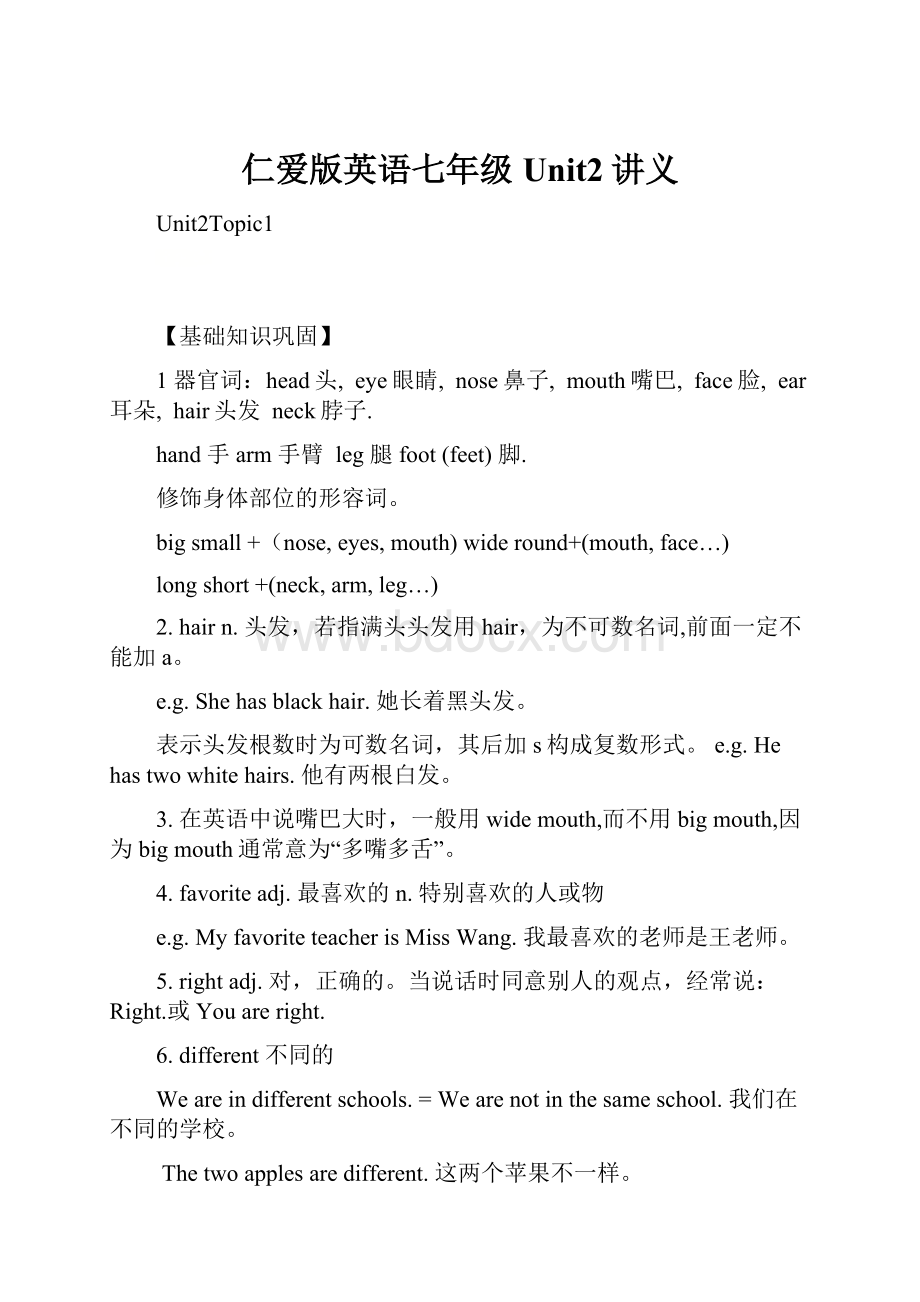仁爱版英语七年级Unit2讲义.docx
《仁爱版英语七年级Unit2讲义.docx》由会员分享,可在线阅读,更多相关《仁爱版英语七年级Unit2讲义.docx(23页珍藏版)》请在冰豆网上搜索。

仁爱版英语七年级Unit2讲义
Unit2Topic1
【基础知识巩固】
1器官词:
head头,eye眼睛,nose鼻子,mouth嘴巴,face脸,ear耳朵,hair头发neck脖子.
hand手arm手臂leg腿foot(feet)脚.
修饰身体部位的形容词。
bigsmall+(nose,eyes,mouth)wideround+(mouth,face…)
longshort+(neck,arm,leg…)
2.hairn.头发,若指满头头发用hair,为不可数名词,前面一定不能加a。
e.g.Shehasblackhair.她长着黑头发。
表示头发根数时为可数名词,其后加s构成复数形式。
e.g.Hehastwowhitehairs.他有两根白发。
3.在英语中说嘴巴大时,一般用widemouth,而不用bigmouth,因为bigmouth通常意为“多嘴多舌”。
4.favoriteadj.最喜欢的n.特别喜欢的人或物
e.g.MyfavoriteteacherisMissWang.我最喜欢的老师是王老师。
5.rightadj.对,正确的。
当说话时同意别人的观点,经常说:
Right.或Youareright.
6.different不同的
Weareindifferentschools.=Wearenotinthesameschool.我们在不同的学校。
Thetwoapplesaredifferent.这两个苹果不一样。
短语inthesameschool中same必须与定冠词the连用,后常接单数名词。
indifferentgrades在不同年级,different“差异的,不同的”,后面通常接复数名词且不加定冠词the。
e.g.indifferentclasses在不同的班级,inthesameclass在同一个班级
7.Isee.我知道了=Iknow
8.Whoisyourfavoriteactor?
9.Ihaveasmallnose,buthehasabigone.我有个小鼻子,但他有个大鼻子。
1)big的反义词small。
2)one在这里是代词,代替前面提到的单数可数名词nose,如果是复数,用ones代替。
e.g.Shehasbigeyes,butIhavesmallones.她长着大眼睛,但我却长着小眼睛。
10.动词have/has表示归属,意为“有”。
主语为第三人称单数时,用has;其他人称作主语时用have。
e.g.Ihaveabignose.我有一个大鼻子。
Shehasbigeyes.她有大眼睛。
1)总结have/has:
I/You/复数代词或名词+have…..我/你/…有……
He/It/She/三单(第三人称单数)+has…..他/它/她/(三单)有……
注:
三单:
1)人称代词he,she,it2)某个人Maria,Kangkang,Michael,myfather,mymother等
3)某件事物。
Thepen,thebook,thecomputer,theprinter,Thegame,thestory,(必须是单数)
2)要把句子变成否定句或疑问句,通常需要借用助动词do或does。
does用于主语是第三人称单数的句子;do用于其他人称。
e.g.
陈述句(肯定句):
Ihaveabook.我有一本书Shehasapencil.她有铅笔
否定句:
Idon’thaveabook.我没有书。
Shedoesn’thaveapencil.她没有铅笔。
一般疑问句:
Doyouhaveabook?
你有一本书吗?
Doesshehaveapencil?
她有铅笔吗?
回答:
Yes,Ido.\No,Idon’tYes,shedoes./No,Shedoesn’t.
注意:
don’t=donot,doesn’t=doesnot
实地演练:
(写出否定句,一般疑问句,肯定回答,否定回答)
Theyhaveroundfaces.
Shehaslonghair.
11.同义句
Myfaceisround=Ihavearoundface.
Hishairisshort.=
Hermouthissmall.=
Shehasshortarms.=
Shehaslonghair.=
【典型例题讲解】
Ⅰ.单项选择。
(10分)
()1.—____isyourteacher?
—It’sMissGao.
A.WhatB.WhoC.WhereD.How
()2.TonyandIaregoodfriends,butweareindifferent____.
A.classesB.schoolC.gradeD.age
()3.Shehasroundface.Herhair____blackandlong.
A.hasB.amC.isD.are
()4.—____WangFanghavetwosmalleyes?
—No,shehastwobigeyes.
A.DoesB.DoC.IsD.Are
()5.找出画线部分读音与其他三个不同的选项。
A.noB.notC.thoseD.zero
()6.—Look,thegirlhaslonglegs.—____
A.You’reright.B.Yes,sheis.C.Thanks.D.Good.
()7.—DoesLiYinghaveasmallmouth?
—No,shehasawide____.
A.itB.thatC.oneD.ones
()8.I____abignose,butAmy____asmallnose.
A.have;haveB.have;hasC.has;hasD.has;have
()9.Theyarein____butin____.
A.samegrade;differentclassesB.thesamegrade;differentclasses
C.samegrades;differentclassD.thesamegrades;differentclass
()10.—Dothetwoboyshavebignoses?
—____
A.Yes,theyare.B.No,theyaren’t.C.No,theyhavebigones.D.Yes,theydo.
Unit2Topic2
【基础知识巩固】
1.颜色(color):
red,white,black,blue,purple,brown,gray,yellow,orange,green,pink
2.Whatcolorisit?
这是什么颜色?
这是由特殊疑问词What(什么)引导的特殊疑问句。
例如:
What’syourname?
What’syourtelephonenumber?
What’sthis/that?
Whatarethese/those?
3.Theybothhaveblackhairandblackeyes.
both意为“两个都”,三个或三个以上的都用all
其位置在情态动词、be动词和其他助动词之后,实义动词(也叫行为动词)之前
e.g.Theyarebothteachers.他们俩都是教师。
4.Theydon’thavethesamelooks,,buttheyaregoodfriends.他们没有意义的外貌,但是他们是好朋友
Wedon’thavethesamelooks.=Wehavedifferentlooks.=Welookdifferent.我们相貌不同。
looks是名词,意为“相貌,长相”。
Theylookthesame.他们看上去一样。
looklike看起来像(外表像)Youlooklikeyourmother.
belike像…一样(指品德、相貌等,更多侧重表示人的个性特征。
)Itwaslikeaflowerbefore.
5.young年轻的/old年老的
6.givesth.tosb.=givesb.sth.把某物给某人
I’llgivethebooktoher.=I’llgiveherthebook.我将把它(信)拿给她。
7.衣服clothes:
cap,coat,pants,skirt,shoes,T-shirt,dress,
8.in+颜色或in+a\an+颜色+名词表示穿……衣服
如:
inred穿红色的衣服inareddress穿红色连衣裙
9.重要问句:
1)问颜色:
Whatcoloristhecap?
(句型结构:
Whatcolor+be+主语?
)
2)问长相:
Whatdoesshelooklike?
(句型结构:
What+助动词+主语+looklike)
【典型例题讲解】
Ⅰ.单项选择。
(10分)
()1.—____orangeis____orange.—That’sright.
A.An;/B./;anC.An;anD./;/
()2.—Whatdoyouwanttobuy?
—____
A.Twopairsofglove.B.Twopairofgloves.C.Twopairgloves.D.Twopairsofgloves.
()3.—____ishiscar?
—It’sblack.
A.HowB.WhatC.WhatcolorD.Where
()4.找出画线部分读音与其他三个不同的选项。
A.buyB.rulerC.muchD.bus
()5.—WhatdoesYangPinglooklike?
—____
A.Heisastudent.B.Helookshappy.C.Helooksatthephotos.D.Hehasabighead.
()6.—DoyouknowAlice?
—____,Idon’tknowher.
A.SorryB.YesC.ExcusemeD.Thanks
()7.—Whatcolor____hershoes?
—Black.
A.amB.isC.areD.be
()8.—Excuseme,isMichaelinblackpantsnow?
—No.He’sin____coatand____pantsnow.
A.black;awhiteB.ablack;whiteC.black;whiteD.ablack;awhite
()9.—Lucy,doyou____yoursister,Lily?
—No,welookdifferent.
A.lookB.lookatC.lookthesameD.looklike
()10.—That’smycap.Please____.—OK.
A.giveittomeB.givemetoitC.giveitmeD.givemeit
完形填空解题技巧点拨
“固定搭配法”解答完形填空题
固定句型和短语搭配不仅是学习的难点,也是完形填空题测试的重点。
固定搭配形式较多,有名词短语搭配、动词短语搭配、介词短语搭配等,这些固定搭配都是语言在长期的发展和演变过程中形成的,是语言的精华,我们只有在平时学习中认真积累,做题时才能得心应手。
做这类题时不需要特别分析就能锁定正确答案。
例:
...Ilostmydictionary.Imustfindit.Ifyoufindit,pleasecallme2898-5508.MyfirstnameisPeter,andmy3nameisBrown...
()2.A.onB.atC.toD.of
()3.A.firstB.goodC.nextD.last
解析:
这是一篇寻物启事。
第2题为固定搭配:
callsb.at+电话号码,意为“拨打电话号码.…..找某人”。
故选B.第3题为名词短语lastname,意为“姓”。
故选D.
阅读理解技巧点拨
“细节理解法”解答阅读理解题
细节理解题主要考察对文章具体事实和细节的理解能力。
我们在阅读文章的过程中,要特别注意与具体题目相关的事实细节,并在相关事实细节处做上相应的记号,以便我们对照具体细节题目,印证文章细节,提高解题的准确度。
细节题目一般只针对文章中的某一细节或若干细节及主要事实进行考察,我们可利用所学的词汇、语法、句型知识及上下文的语境做出判断。
例:
Thisismyroom.Thebooksareinthebookcase.Thepictureofmyfamilyisonthewall.Myschoolbagisonthechair.AndIhaveasoccerball.It’sonthefloor.Acomputerisonthedesk.Sometapesarebehindthecomputer.AndIhaveacat.It’sundermybed.
根据短文内容回答下列问题。
1.Wherearethebooks?
2.Whereisthecomputer?
答案:
1.Theyareinthebookcase.2.Itisonthedesk.
解析:
这是一篇介绍“我的房间”的短文。
第1题由短文第二句“Thebooksreinthebookcase.”这一细节可知书在书橱里;第2题也是考查细节理解,根据“Acomputerisonthedesk.”可知电脑在书桌上。
典例分析—必考知识点汇编
考点1表示身体部位的名词
【典例1】Theboyhasbig____andlong______..
A.ear;hairsB.ears;hairs
C.ears;hairD.ear;hair
考点2动词have表示“有”的用法
【典例2】_____she____awidemouth?
A.Does;hasB.Do;has
C.Does;haveD.Do;have
【典例3】Histeacher_____bigeyes.
他的老师长着大眼睛。
考点3one作代词,替代已经提到过的或已经知道的某个名词
【典例4】—Doyouhaveaknife?
—Yes,Ihave_____.
A.aB.anC.oneD.it
考点4be+形容词
【典例5】He______verystrongandhe______shorthair,abignoseandawidemouth.Whoishe?
A.has;isB.have;is
C,is;hasD.is;have
考点5描述身体部位的形容词
【典例6】JackieChanhasa______mouthandabignose.
A.bigB.wide
C.longD.round
考点6in的用法
介词in可以意为“穿着”,结构为“in+a(an)+颜色+单数可数名词”或“in+颜色”表示“穿着……颜色的……”。
【典例】Theboy______abluecapismyfriend.
A.ofB.withC.in
【解析】Ctheboyinabluecap指“戴蓝色帽子的男孩”,介词in表示“戴着”的意思。
考点7have的用法
【课文原句】Wehaveblackhairandblackeyes.(教材P35)
Sheistallandshehasshortbrownhair.(教材P37)
【典例】Shedoesn’t________atoy,butI______one.
A.have;haveB.have;has
C.has;haveD.has;has
考点8颜色词的用法
对句中表示颜色的词提问用whatcolor。
句型结构为:
“Whatcolor+—般疑问句?
”答语为“It’s+颜色”或“They’re+颜色”。
【课文原句】
【典例】—Whatcolorisyourcoat?
—________.
A.It’sthered.B.It’sared.-C.It’sreds.D.It’sred.
考点9描述性形容词的用法
英语中多个形容词同时修饰一个名词时,大致遵循下面的规则:
限定词+数词+描绘性形容词+大小、长短、高低、新旧+颜色+国籍+材料+被修饰名词。
【典例】—Whatdoesshelooklike?
—Sheistallandshehas_______hair.
A.shortblondB.blondshortC.bigblond
考点10动词look的用法
look表达“看某物时”后面要加上介词at,即lookat+某物。
【典例】________thisphoto.Itisverynice.
A.LookB.LookatC.MeetD.See
考点11give的用法
【典例】Pleasegivethisletter_______Maria.
A.inB.fromC.toD.for
练习检测
句型转换。
1.Hehasshorthair.(改为一般疑问句)
____he____shorthair?
2.Doyouhaveasister?
(作否定回答)
____,I____.
3.Shehaslonglegs.(同义句转换)
____legs____long.
4.IamfromChina.(同义句转换)
I________China.
5.Wearen’tinthesameclass.(同义句转换)
Wearein________.
根据短文内容,从方框中选择合适的词填空,每词限用一次。
otheryoungnextbutman
Thisisaphotoofmyfamily.Theyoung6ismydad.Heisnottall,7heisstrong.Heisinawhiteshirtandblacktrousers.The8womanismymom.Herhairislong.Sheisinabluedress.Theboy9tomymomismybrother(弟弟).The10boyisme.Welookhappy.
6.7.8.9.10.
完形填空。
Hi,Ihavetwofriends.Theyaretwelve16.Nowweareinahighschool.They17fromEngland.Lookatthe18.HisnameisJim.Hehasa19face,abignose,asmallmouth20smalleyes.Thisgirlishis21,Jane.SheandJimarefrom22samefamily.Buttheylook23.Shehasalongface,asmall24,asmallmouthandbig25.Theyaremygoodfriends.
()16.A.yearsoldB.yearC.yearoldD.years
()17.A.welcomeB.comesC.comeD.is
()18.A.girlB.boyC.momD.sister
()19.A.wideB.shortC.rightD.round
()20.A.andB.butC.andaD.buta
()21.A.sisterB.teacherC.friendD.student
()22.A.aB.anC.theD./
()23.A.sameB.differentC.thesameD.thedifferent
()24.A.faceB.mouthC.eyesD.nose
()25.A.armB.hairC.eyesD.neck
阅读理解
Lookatthephoto.Thetwogirlshavebigblueeyesandlongbrownhair.Theyareten.Theyareinthesamecl